|
|
Review GSM phone Siemens SXG75
Package:
- Handset
- Stereo headset
- Li-Ion battery 1,000 mAh
- Charger
- Manual
- Mobile Navigation QuickStart
- AD Leporello
- CD-ROM with software for synchronization
- RS-MMC for 1GB (premium shipment, the standard kit has not card included)
For sure all Siemens' worshipers were waiting for this model and were placing great hopes on it. They thought this release would result in the company's revival. Forums boiled with passion, the version of the OS was discussed and technical specifications. And after mobile department of Siemens came under the wing of a Taiwanese company of BenQ passions concerning the model only grew. Most loyal worshipers of the company convinced doubting ones of the technological hitch this model would bring. And finally we received a working sample of the phone, and it will highlight key points. So, let's check it inside.

The handset turned out rather big and heavy. Considering the weight and size, you are likely to imagine not small owner. And that is most probable a man, as the weight of 134 g and dimensions of 111x53x20 mm would look strange in a woman's handbag, and let alone her arms.

There are two colour versions. One is completely silvery called "Metallic White" and one with a black panel - "Metallic Black".
Looking at the front panel of the phone rouses nostalgia of the first company's smartphone Siemens SX1. Two buttons are placed on both sides of the screen. However, unlike the SX1 with al its buttons placed vertically near the screen, this model provides some efficiency. Today Siemens is not the only to place functional buttons on the edge of the panel. And another example is Sony Ericsson K600i.



The screen takes about a half of the front surface. This model is equipped with a 2.2" display (TFD) showing 262K colours and the resolution is 320x240 pixels, while the physical dimensions equal 48x37 mm. The picture will surely gladden with brightness and colour richness. Reading text will be of no trouble. In fact this display will give odds to the one in Nokia 6280. The latter is not even average in quality - it is one of the best Nokia's screens today, however even in this condition pictures and texts on Siemens' new phone look brighter and more contrast. From 7 text lines (the smallest font size) to 3 can feature the screen depending on the font-size. And even more, besides two service areas on the top and bottom of the display, two mode service bars appear above the text area when entering a message. The first one displays current date and time, and another line shows the sender's (recipient's) number. You will surely find no difference between Russian and English fonts. Bold text looks less elegant, which is a significant difference from fonts installed in Nokia 6280. Its fonts look equally well independent of size and weight.
A VGA camera is placed in the top left corner, which helps making video calls. You can access the VGA camera pressing fast access buttons to the left of the screen, and a call one is nearby. Browser and cancel buttons are symmetrically placed on the right side. The bottom of the panel features a keypad block, where call and cancel buttons are replaced with a task manager and C buttons. The C key functions inferiorly, which means it edits characters only in texts. You can use option menu to delete files from the menu. The task manager will let you surf on running programs. A good example is you write a text note while speaking on the phone. However this handset is a complete multitasker. Firstly, you can run only one Java applications at a time. And on an attempt to open another program using Java, you get an alert about already running application. Running a new task you should check to quit the previous one. At the same time you can open several folders and run a message editor, a stopwatch, a countdown timer and a player. But nevertheless only one application of one kind can run on this phone at a time unit. You will fail to start already running application.
Small number keys are projecting and placed in straight rows. By default an application is assigned to every key. Or you can use a number key for fast dial. Fortunately, keys are well distanced and then blind work will cause no trouble. However, some users may dislike tough pressures on the keys. The joystick is quadrangular with edges above the main keypad, and a confirm button is deepened slightly. I found this joystick comfortable in work and no accidental pressures bothered me.

The left phone facet features a videocall, a mediaplayer buttons and a memory slot. In fact the card holder has a poor construction (that is an external housing) as the card should go upturned. At the same time restrictive edges of the holder appear beneath. If you take the card out above the table, nothing bad will happen, as it falls on the table. But a worse case is fulfilling this operation in the street. To prevent the card from falling on the ground, you should hold it with your finger. Press a deepening in a small button to the left of the connecter to remove the card. And the front facet of the holder acts as a stub. Hot card change is at your disposal. The card format is RS-MMC with standard 3.3V, not Dual Voltage. And the maximum size of the card claimed by the maker is 1 GB. This handset will fail reading a RS-MMC Dual Voltage card.

Two volume adjusting buttons and an IrDA gap are on the right side. And a connectivity slot is on the bottom end.
The top of the back panel holds a slot for an external antenna which features a rubber stub. A perforated plastic grate closes the middle of the panel. You will find stereo loudspeakers providing volumetrical and rich sound under it. And a 2MP camera objective found place on the right side. Only a silvery rounding projects above the surface, while the very objective is sunk into the body, which protects from scratches well, but dust and dirt are free to appear. You will not find a mirror for self shooting and a flash in this model.


The bottom of the panel is silvery white and closes the battery compartment. The cover joins very closely so it makes no gaps, and you will need real effort to remove this cover. Fortunately, the applied grove construction prevents accidental opening. The phone is equipped wih a Li-Ion battery of 1000mAh, which provides about 2 days of work in case of 20-30 minutes of talks and up to an hour and a half of other functions. When we tested the handset, we had the screen backlighting permanently on and up to 15 minutes of talks, so the model worked only for 2 and a half hours. An ordinary SIM-holder is a cross-cut crampon, and you will need to turn up the edge of the SIM to remove the card.

You will surely appreciate high assembly quality. All moving parts join perfectly well and no creaks and gaps in joins. And a user also should treat the handset corresponding to this scrupulousness in assembly. Plug the back panel exactly in the groves; however, if you do it incorrectly, the cover won't close.
About 72 MB of dynamical memory are provided to a user, while the total memory bank reaches 128 MB, still the rest of the memory is allocated for system files and thus is not shown to a user. Any application can use all free memory. Phone and memory card contents are shown separately.
You can select an "aboard" profile instead of "on-line". Then your phone works as an organizer, it is easy and makes no problems to switch an organizer mode from the active one. But nevertheless the handset can't work without a SIM card; this work mode is not realized.
Finally, now you do not have to confirm your action when turning the phone on. Almost each model by Siemens released before required a confirmation of turning the phone on, which irritated almost every user. I'm glad the developers finally trusted good will and common sense of phone owners.

Menu.
The menu appearance is traditional for the 75-th series. A screen saver image doesn't cover the top and bottom service areas of the screen. The only way you can have the menu is 3x4 matrix. The icons have the same design as used in the S75, however a higher resolution made them look much more pleasant, especially that concerns graphical screen themes. And the second level of the menu is standard. You can access nested items by horizontal deviations of the joystick. Using graphical themes (there are 5 presets), you can change the background or a screen saver image.
Contacts.
The address book allows about 500 entries. You can keep about four phone number, two fax numbers, four e-mail addresses, two site URLs, and a Company name and so on. At that phone numbers are shown in one window, and fax numbers are kept on private and business bookmarks. First names in English appear in the general list and local languages then. You can assign an alias to any contact, but then it will be displayed in a special order depending on the language a real name is entered in, then an English nickname can appear among Russian names.

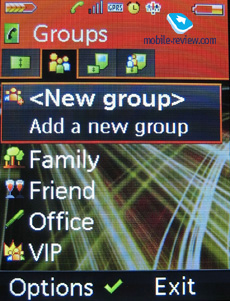
 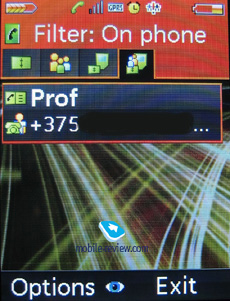
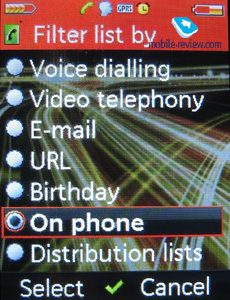 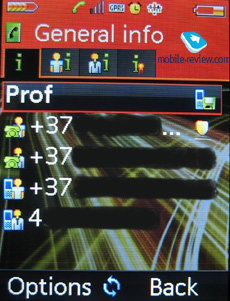
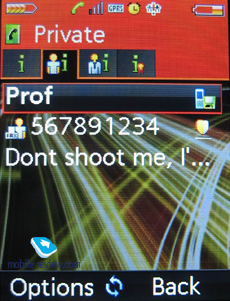 
 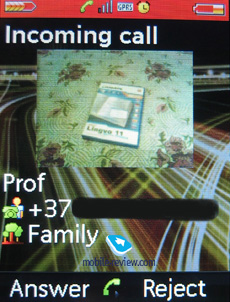
 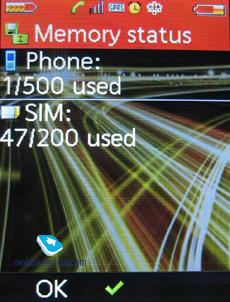
A personal melody, an image, a group and a birthday are available. SIM contacts can be viewed in a special menu item. There are 4 groups by default; however you may create an unlimited number of new ones. As for me, I created 35 new groups to check the previous statement, and then stopped. A group allows a personal melody and picture.
The SXG75 is a real leader in sorting capabilities. You can have the user output sorted by videophone, e-mail address, site URL, birthdate or a mailing list, and sorted data is shown in another window! Voice tags are available for a fast call. Voice synthesizer functions are absent, however, about 100 voice tags can be recorded, with up to several for a contact, but only one per a name. Holding the navi button in the up position, you can call the voice tag. An interesting fact is you can't set various filters for various groups, and only the last filter works.
Log.
The log contains entries about 100 calls of each type - incoming, outgoing and missed. All calls are also shown in a general list with a corresponding icon. Details on each entry will provide you with time and date of the call. Traditional restrictions by call cost and duration are present; they require your PIN code.
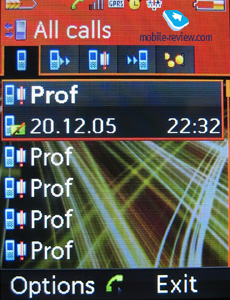 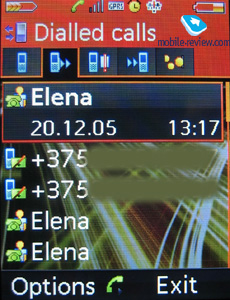
 
 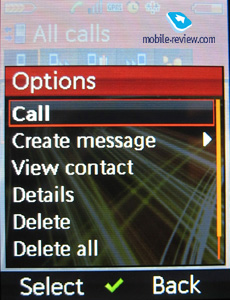
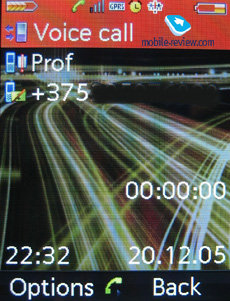 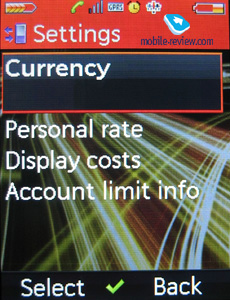
Internet.
A preinstalled WEB-browser supports HTML protocol. While English pages are shown so-so, you will surely be disappointed with Russian ones. That seems like the very primordial localization, and much work is to be doe.
 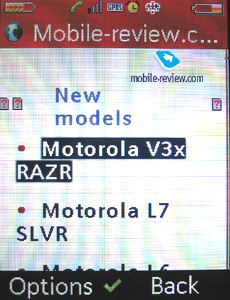
 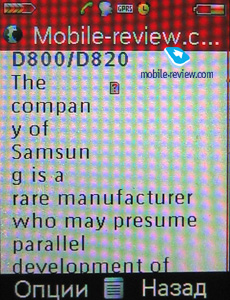
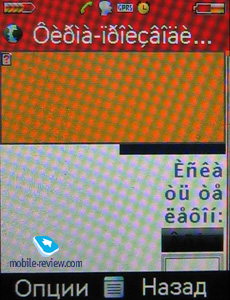
Camera.
The 2MP camera is equipped with a CMOS module and allows photos with the maximum resolution of 1600x1200 pixels (the other resolutions are 1280x960, 640x480, and 320 x 240 pixels). Also you can adjust white balance (auto, indoors and outdoors), screen update (50 and 60 Hz), file path (for saving). No autofocus.
240x180
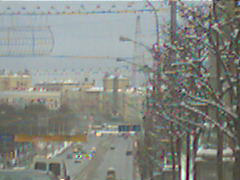
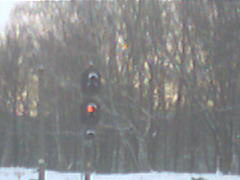
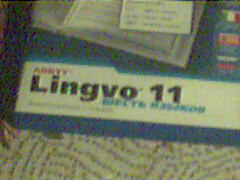 320x240
320x240
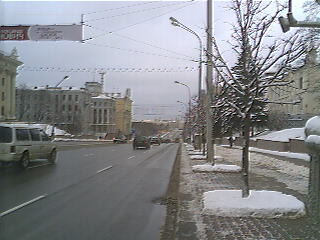
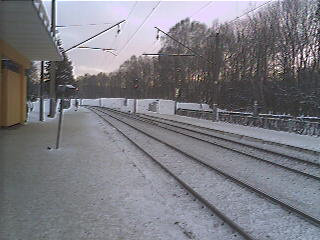
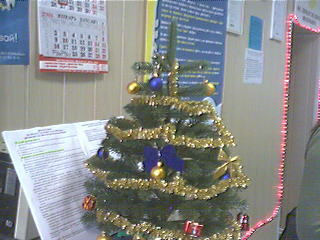
|
|
 |
 |
(+)
increase, 1600x1200, JPEG |
(+)
increase, 1600x1200, JPEG |
 |
 |
(+)
increase, 1600x1200, JPEG |
(+)
increase, 1600x1200, JPEG |
 |
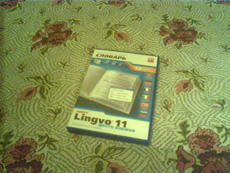 |
(+)
increase, 1600x1200, JPEG |
(+)
increase, 1600x1200, JPEG |
 |
 |
(+)
increase, 1600x1200, JPEG |
(+)
increase, 1600x1200, JPEG |
We compared photos taken with this camera and ones of the same class (Nokia 6280 and N70), that revealed Siemens' photos deepen into the blue area of the spectrum much, which makes the pictures look cooler. This is striking at a sunny day when taking photos of golden cupolas, however indoors the effect is the same. In a cloudy day, you will have this colour difference smoothed, but still noticeable.
Siemens SXG75 -- Nokia N70
|
 |
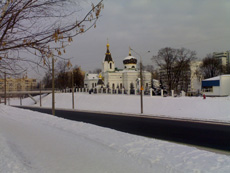 |
(+)
increase, 1600x1200, JPEG |
(+)
increase, 1600x1200, JPEG |
 |
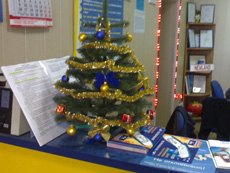 |
(+)
increase, 960x300, JPEG |
(+)
increase, 960x300, JPEG |
 |
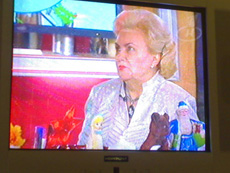 |
(+)
increase, 640x480, JPEG |
(+)
increase, 640x480, JPEG |
In poor light conditions the camera's noises raise traditionally, and colour artifacts appear on the photos, however backlit objects look good on night photos. A peculiarity of the digital zoom leads to an effect when an image loses contrast at the maximum zoom value. I was amazed at how bad photos look if taken in artificial light. And the absence of macromode is a real disadvantage.
The camera can record video clips with the resolution of 176x144, 128x96 and 96x80 pixels. The frequency of 7 and 15 fps at your disposal and the maximum duration reaches 5 minutes. A clip recorded in MMS mode can last for up to 10 seconds. Digital zoom doesn't work during recording. The frontal camera allows changing only the resolution - 352x286 and 320x240. And in fact I didn't expect such a capability as using a frontal camera for video records. That is very exotically. A possible way to use this capability is shooting object behind you, and even more - you can switch a shutter sound.
Video sample 1 (3GP, 84,2 KB)
Video sample 2 (3GP, 79,3 KB)
Video sample 3 (3GP, 228 KB)
Video sample 4 (3GP, 216 KB)
Video sample 5 (3GP, 227 KB)
Video sample 6 (3GP, 844 KB)
Video sample 7 (3GP, 112 KB)
Video sample 8 (3GP, 432 KB)
Video sample 9 (3GP, 233 KB)
The main camera records with rather poor quality. Photos with the nominal resolution look acceptably, however raising the resolution you have the picture less sharp and clear. Some fragments of the image can be lost when shooting an object in motion. Still colour range remains moved to cool blue as compared with Nokia 6280, but Siemens' image looks better after postprocessing, as Nokia's clips show more pixelization.
I can't understand why the developers refused flash and a mirror, and I was really pleased with a capability to use a powerful light diode lamp (for instance, when you try to find a keyhole in the dark) in the S75.
I can easily predict the emotions you have after using the camera. The pictures do not stand out for high quality, the colours are cool. Digital zoom fails at high scale. So, in general, you won't have a chance to take a professional photo with this camera, however it will suit for sending photos via MMS.
Messages.
Three types of messages are available - SMS, MMS and E-mail. Concatenated SMS can reach 755 characters in length if you use Latin and 330 characters in case of Cyrillic. Expanded mode is not supported - you can only insert a text template and a contact from the phonebook. T9 dictionary is provided, however without automatic word insert. You can add words to the base. They will be easily recognized at later text input. When entering text in usual mode, you will have a traditional text line prompt appear. And traditionally order of Russian characters on the buttons mismatches the one in phones by other makers. Usually I enter texts blindly, and thus I had several mistakes, however that is a matter of a habit.
 
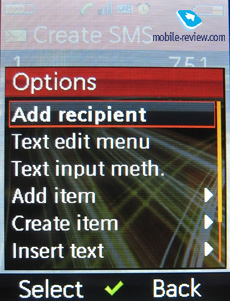 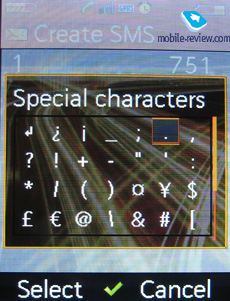
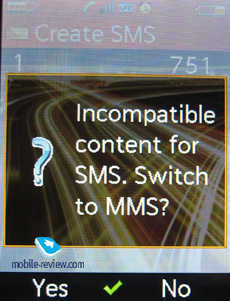 
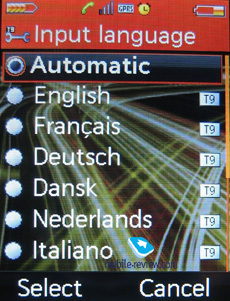 
You can attach a picture, a text fragment, video, sound file and a contact to an MMS, that means all usual functions are present. You can take a photo, record video and sound directly from the MMS editing menu. The maximum size of an MMS is 195 KB. Also a limit of 95 KB (many operators limit the size to 100 KB) is present and a special option - the network limit. My operator sets a limit of 100 KB, and that is why I failed testing the maximum size in ideal condition.
When you create an e-mail message you must create a profile, otherwise even a menu item won't open. The mail client supports such protocols as SMTP, POP3, and IMAP4. And even unsupported file types can be attached, the maximum size of an attachment should not exceed 10 MB. Russian encodings are used incorrectly. But do not forget that an engineer sample was tested, and some problems will be solved by the official release, however others may take much time. Considering real experience of dealing with this company, I suppose that the model will be developed completely only in half a year after the start of official shipments.
All available memory is used for saving, memory card is not enabled.
The phone provides no preset templates. You have to create own ones. And such template can be used either as a heading or a signature to a message. Voice mail box is adjusted from here.
Organizer
Contains a calendar, voice reminders, time zone settings and synchronization.
The calendar is realized very well in this model. Each new event belongs to no type from the beginning. A theme, starts time and date, end time and date and a signal time (if necessary) are set for each entry. Then event recurrence is adjusted (daily, weekly, monthly, annually and never). In fact this way to form memos brings to an idea that it is an expanded alarm clock. The only disadvantage is no exceptions can be set (I mean week-end, for instance). However, even this problem is solvable. You can set reminder for Saturday and Sunday and then set weekly recurrence. Only free memory limits the number of entries. The last statement belongs to the developers, and I failed carrying out an experiment. The previous Mobile Phone Manager (shipped with the S75) doesn't support this handset. A new version of the connectivity software is still unavailable, and I lost my patience to enter 1000 events manually.
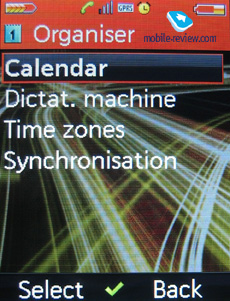 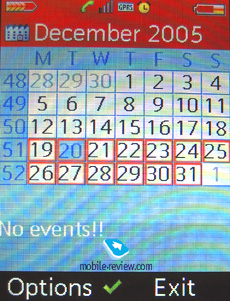
 
 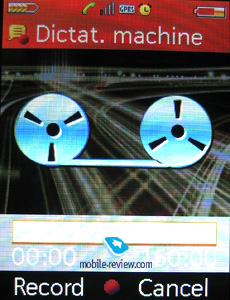
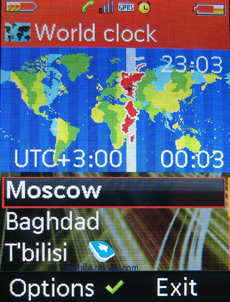 
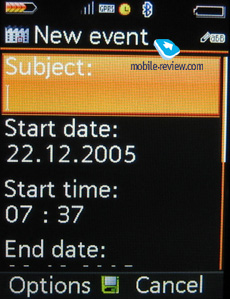
A Dictaphone allocated in this item is called voice memos. And total entry duration forms 150 hours. That is more than necessary considering the maximum battery life. However this dictaphone doesn't work during a conversation. And if you attempt to call the task via active menu, you get a message about an unsupported function.
Time zone function is usual. You can view time gap between two selected cities.
Synchronization. Here you can select "over the air" synchronization, select applications, set a profile and type of data exchange. Messages and contacts can be kept on external servers (SyncML protocol). You will experience no problem synchronizing with a remote site, however data exchange with a PC is impossible due to the reasons described above.
Games
Four games are preinstalled on this phone. They are "Space shooter", "Marble Crossing", "Super Bomberman" and "Space Stack Attack". The games start and play with no noticeable slow down, they are carefully minimized at a call and then resume after the call is over. The same concerns other Java applications.
 
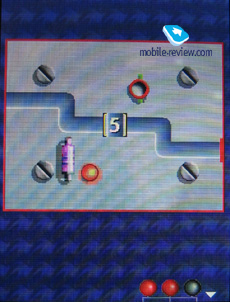 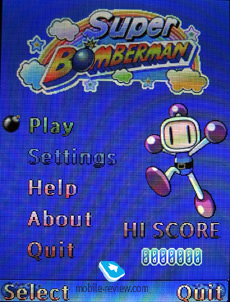

Mediaplayer
The player is located in a separate menu item and comes equipped with a special icon (similarly to the S75). Like the S75, this phone uses a multimedia CPU Imageon 2182 by ATI. However, the functions of this chip are realized fully as compared with the S75. And that is why this phone can play Real Media 8/9 besides traditional media files (ringtones, аас, mp3, 3gp, and graphics). Media files can be viewed full screen. Playlists can contain up to 25 files, background mode is realized. Slide show mode is provided for graphics.
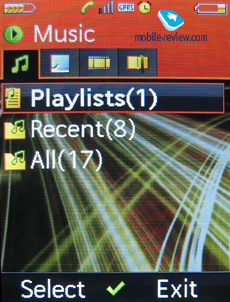
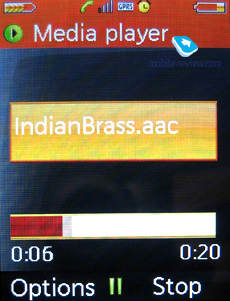 
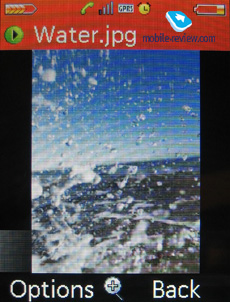 
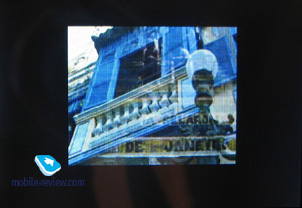
This phone turns into a fully-functional portable mediaplayer with its capability to play rm format, large screen and stereo loudspeakers. The only restriction on the rm-video is no full-screen playback. Demo window turns to landscape, but can't grow in size. I would like to stress that I used files specially converted to smartphone resolution (176x208 pixels). The problem perhaps can be solved by changing the frame geometry. On the other hand, even smartphones got a capability to play RM-video full-screen not long ago. And anyway, this question requires further study.
Playback is stopped after an incoming call, and then you will have to switch from the pause mode manually. That is a disadvantage, as the player can't do it automatically.
When you copy folders to the memory card, folders are duplicated. And if you delete any of these copies, the phone buzzes at all. Then only reload helps start working.


Videotelephony
This item is useful only in 3G networks. On your attempt to cal in usual GSM-network, you get an error message and an offer to use voice call.
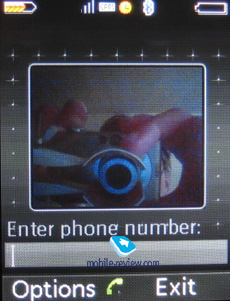 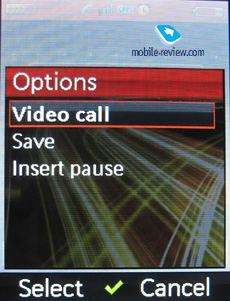

Extras
To tell the truth, I can't call such distribution of application among folders very logical. Many of them are duplicated in various menu items, and that is why I will highlight only innovations.
Mobile navigation.
This phone stands out of a crowd of similar models for its integrated GPS receiver, which uses satellite data for location. To increase the accuracy operator's servers can be used for location using A-GPS. Being rather a common feature of communicators and PDAs, still GPS modules remain a rare part of usual phones. As the test sample had only settings for the European Council, I couldn't check the service seriously. And location caused an error. Nevertheless, a demo clip tells the phone supports a previously set route, voice alert is given when changing the direction, and maps are constantly uploaded from the Internet. So, you should only wait for the final localization of the phone. Then maps for Russia and contiguous countries may be provided. But now the navigator is absolutely useless. In fact it failed even detecting current position data with longitude and latitude even without any regard to a map. As the manufacturer claims, the model can connect to a car kit via a Bluetooth profile, as using the navigator without a car seems quite illogical. And only after final localization this statement will be checked.
Alarm clock. Alarm clock has an interesting peculiarity. Personal once alert can be set for each week-day. And other memos can be created using the calendar functionality.
FM-radio works only with the headset connected. You can scan the air and save about 10 FM stations. The receiver is quite sensitive and supports steady connection. RDS signals can be processed. However like the player, it can't resume after a call automatically and leaving a pause mode is also manual. You are not allowed to record sound.
Calculator. Calculator has expanded mode, where you can calculate an exponent, a square root, and reciprocals. One of the options is a usual converter. However a special option can also run a converter from the menu.
Sound recorder is a dictaphone described above.
Stopwatch allows measure time and fix intermediate values. There may be about 100 of them.
My files
Here is a traditional Siemens' file manager. Folders with games and applications can be viewed from here besides usual ones with graphical, video, theme and sound contents. Applications are not shown in other menu items.
Preinstalled applications include "Doc Viewer", "My photos online", "Mobile navigation", "PDF Viewer", "Photo Editor" and a "Rescue dictionary".
Now, very shortly about these applications. Theoretically, the "Doc Viewer" has to show MS Office documents on the screen. And really it processes a preset plain text file and a table file. But it failed working with any exterior file. An application reported an error at load. I used even the simplest documents containing only several lines. But nevertheless the handset failed the operation. And completely the same can be told about PDF Viewer. And it would be nice to see in a manual how files should be converted when transmitting them from a PC.
"My photos online" allows uploading own photos on external servers. And a "Photo Editor" is a powerful mobile image editor. However that takes so much time! You will find it easier to edit the image on your desktop PC if necessary. And a dictionary may be the most demanded. It allows making translations of the most common phrases from six languages almost in no time. But you will have to enter the phrase and its meaning in the demanded language, the dictionary can't perform it automatically. The application doesn't provide voice playback of phrases from the base, however, that is more a dream.
And some ideas about Java applications in the end of this part. The manual notifies that DRM digital signatures are checked. And a possible consequence is you can't run Java applications saved on external memory card or transmitted from another device, for instance, a PC. When you send these applications via a wireless channel, they appear in a folder "Miscellaneous" and are not recognized. The same concerns copying to a memory card. However the fact South-East developers prepared the phone may be another reason. They like to install Java from the WEB, and that is well known. The same applications downloaded from the site were defined and started well. Oh, the only thing left is feel pity that the fine time when you just entered a folder java/jam and copied a folder named after a jar-file inside comes to unavoidable end. At first I suspended that while testing the S75, but then some files ran nevertheless. And now a question - what should numerous book-lovers do? The large screen and good memory size suited them perfectly. We should only hope on enthusiasts who worked out even harder tasks.
Settings
Traditional test packages JBenchmark 3В, 1.1 and 2.0 were used for testing the performance. The tables below show the test results compared with similar models.
The results of tests that were carried out with the Java machine.
In fact, I noticed no differences in a list of possible settings between the tested handset and the S75. The only one is perhaps a vibracall. And that was absolutely right to remove corresponding images from this item. Profiles with various vibro types remained. You can set memory card as a destination point for reception via IrDA. And the same concerns Bluetooth. I noticed no problems with these services during the tests. Everything is received and transmitted where necessary. Bluetooth settings now lack data about supported profiles. Now here are settings for fast access with soft- and number keys. All the rest is customary.



3D Java-tests are of the greatest importance. Almost all the tests revealed that the JM of the SXG75 worked faster than in other phones of the 75th series.
A professional version of SPMarkJava06 by FutureMark showed very modest results. This company is known for its 3DMark tests for graphical accelerators. And despite applied tests are rather synthetic they still prove information to judge the productivity of the hardware. I supposed that a powerful CPU is necessary for the GPS navigator, but that turned out wrong, and thus running "heavy" 3D games will be quite problematical. A possible objection that the phone is a business model and is not designed for games reminds of the situation with the S65, where an mp3 player was absent due to the same reason. In later models the player got legitimate again. And I prefer to believe that will happen with 3D Java also, as not only business users buy such phones.

Low results of 3D tests reveal that the graphical accelerator is off during Java work.
Impressions
When I tested the phone, I used it as my main handset for about a week. Then I faced no problems with connection quality. The loudspeakers happened enough loud for conversations even in noisy streets. And when listening to the radio (sound directed to the loudspeakers), I even had to decrease the volume. The sound was also very qualitative, however high frequencies sometimes reveal noises. Midi compositions sound well. The vibracall is traditionally very powerful, and it may be used as the main call alert. The integrated graphical accelerator works at full-load. This handset can replace a portable media player for video demos in the most popular formats like 3GPP and RM. A great plus is you can sort entries in the phonebook by various parameters, but its capacity of up to 500 users seems outdated. Voice dial is also an advantage, but it requires primordially recorded tags. Modern rival models allow voice recognition without previously recorded tags. I really liked the calendar. It practically places no limit on the number and format of entries and can be used as a daily timer. If you have some event repeating daily, just enter it into the calendar and you will ever miss it.
But nevertheless, the phone contains some disadvantages. The changed version of the operating system now prevents from direct work with Java applications from the memory card or Bluetooth. That immediately cuts off those users who like reading from the phone. The integrated GPS navigator will be of any interest only on the assumption of full localization with support for local maps. Now it is almost useless with the current software. Women audience is excluded due to big size and weight of the device. Office documents are not supported fully either. In fact incompatibility to record a conversation with a dictaphone disappointed much. To observe the low base they could just make a sound signal notifying the interlocutors.
In the end, the model rouses many questions. The ideas are perfect, but the realization is awful. Real innovations are followed by obviously outdated solutions. The consumer market is very narrow for this phone at the present software version. All ideas fulfilled in the handset are now in hands of the new owner - BenQ, and their presence in new phones wholly depends on this company. It seems that the device lacks very little to be a fully-functional and modern phone. And we still can hope that all works to solve problems with localization will have been carried out and all innovations placed in the phone will have had an adequate fulfillment by the official sales.
The discussed phone is a high-end one, and the start price will exceed 500 USD. Siemens was obviously too late on the market with such a model, as there are similar phones with close functionality. But if the operating system remained open, then only time is required to have it finally developed. And here I should notice that the company still preserved many worshipers. So, you can decide whether to buy the model or not just after the main raisin of the phone works well - I mean the integrated GPS receiver.
Videoclip 1 (285 KB, AVI)
Videoclip 2 (713 KB, AVI)
Videoclip 3 (765 KB, AVI)
Videoclip 4 (1,47 MB, AVI)
Videoclip 5 (1,13 MB, AVI)
Links on the topic:
Victor Dashkevich (v.dashkevich@gmail.com)
Translated by Maria Mitina (maria.mitina@mobile-review.com)
Published — 10 January 2006
Have something to add?! Write us... eldar@mobile-review.com
|
News:
[ 31-07 16:21 ]Sir Jony Ive: Apple Isn't In It For The Money
[ 31-07 13:34 ]Video: Nokia Designer Interviews
[ 31-07 13:10 ]RIM To Layoff 3,000 More Employees
[ 30-07 20:59 ]Video: iPhone 5 Housing Shown Off
[ 30-07 19:12 ]Android Fortunes Decline In U.S.
[ 25-07 16:18 ]Why Apple Is Suing Samsung?
[ 25-07 15:53 ]A Few Choice Quotes About Apple ... By Samsung
[ 23-07 20:25 ]Russian iOS Hacker Calls It A Day
[ 23-07 17:40 ]Video: It's Still Not Out, But Galaxy Note 10.1 Gets An Ad
[ 19-07 19:10 ]Another Loss For Nokia: $1 Billion Down In Q2
[ 19-07 17:22 ]British Judge Orders Apple To Run Ads Saying Samsung Did Not Copy Them
[ 19-07 16:57 ]iPhone 5 To Feature Nano-SIM Cards
[ 18-07 14:20 ]What The iPad Could Have Looked Like ...
[ 18-07 13:25 ]App Store Hack Is Still Going Strong Despite Apple's Best Efforts
[ 13-07 12:34 ]Infographic: The (Hypothetical) Sale Of RIM
[ 13-07 11:10 ]Video: iPhone Hacker Makes In-App Purchases Free
[ 12-07 19:50 ]iPhone 5 Images Leak Again
[ 12-07 17:51 ]Android Takes 50%+ Of U.S. And Europe
[ 11-07 16:02 ]Apple Involved In 60% Of Patent Suits
[ 11-07 13:14 ]Video: Kindle Fire Gets A Jelly Bean
Subscribe
|































































































